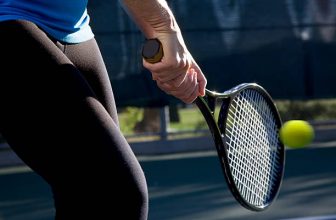Tennis 101: How To Get The Right Grip

You’ve decided to pick up a racquet, jump on the court, and start playing some tennis? You’ve found everything you need, you feel comfortable in your apparel, and you’re just hoping your energy matches your level of excitement.
Among the first things to think about whether it’s a match, warm-up or a training session; is how to hold the racquet in your hand. Most people have one arm that is significantly stronger than the other, so we will presume that your dominant arm is the one you grabbed the racquet with in the first place.
Now it’s time to get the right grip.
What is grip?
Simply put, a grip is a way of holding the racquet. It dictates how you will hit the ball during play. You can probably imagine that different grips will make the ball travel to different spots at different speeds.
A single grip is not enough to be able to perform at a professional or even competitive amateur level. At the beginner tennis level, you may pick one, and stick to it for most points, but once you reach the intermediate level, you’ll want to begin learning additional grips.
What types of grips are there?
Tennis handles are an octagonal shape (a shape with 8 sides). If the racquet handles were square, it would probably hurt the players, and if they were rounded, they would probably be slippery and difficult to grip.
We will use the base knuckle of your index finger as a reference to help explain every grip. Above is a diagram of the racquet handle with a number for each bevel.
There are three main grips in tennis, with a few variations:
Continental grip
This grip is also called a Hammer grip or Chopper grip, because a racquet in your hand looks as though you are holding a hammer or an axe. The base knuckle of your index finger is placed at bevel #2. This grip is very popular among beginners. In professional tennis it is used for serve and volleys, because it allows a natural movement for the wrist and forearm. It is also very good in terms of defense.
Eastern grip – forehand and backhand.
The change from Continental to Eastern forehand grip is very easy, you just need to slide your hand clockwise (counter-clockwise if you are left handed) one bevel. The base knuckle of your index finger is now at bevel #3.
If you wish to achieve an Easter backhand grip, start from Continental grip and slide your hand counter-clockwise (clockwise if you are left handed) and position it at bevel #1.
Western grip – forehand and backhand.
The Western forehand grip is achieved when you place your hand so that the knuckle of your index finger is at bevel #5. This grip gives an extreme spin to every ball, but is very difficult to master and play, especially when it comes to low balls.
Western backhand grip requires the knuckle of your index finger to be at bevel #7. If you play an Eastern forehand, there is no need to alter the grip for the Western backhand.
There are, of course, variations to these three main types. We will just mention the semi-western grip, as it is the most popular grip for the pro players forehand, and you can form it by moving your knuckle one more bevel clockwise from the eastern grip (counter clockwise for the left-handed players).
Here Joe Dinoffer, Master Professional in both the PTR and USPTA talks about proper grips.
Source: 200 Secrets of Great Tennis
Grip Evolution
The western grip was considered to be the best forehand solution in the first few decades of the 20th century, but it fell out of favor until recently.
With modern racquet technology, current player strategies and the overall shift in sport dynamic towards power-based play, western grip has had quite the comeback.
The semi-western grip is the most popular grip on the Pro Tour, as we already stated. As for the backhand, the most common combination is a continental grip for the dominant hand and semi-western grip for the non-dominant hand. Some rare but shining examples even use the western grip for the one-handed backhand.
Which One to Choose?
If you are just starting with your tennis training, you will probably feel comfortable with using the continental grip at all times.
This choice gives you the opportunity to focus on other aspects of the game, rather than thinking about switching grips. However, it will probably leave you with very little attacking options against your opponent. Once you start making progress, you will feel more secure about your game and be ready to try the other grips.






